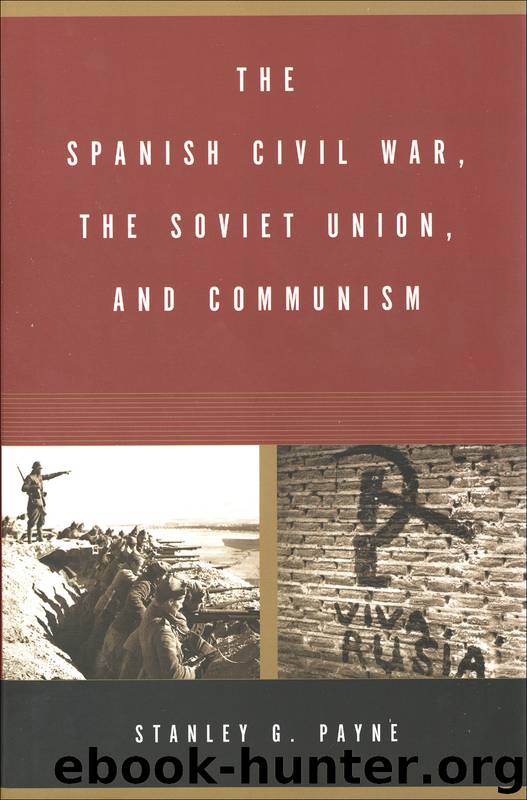The Spanish Civil War, the Soviet Union, and Communism by Stanley G. Payne

Author:Stanley G. Payne
Language: eng
Format: epub
Publisher: Yale University Press
Published: 2004-12-09T16:00:00+00:00
CHAPTER TEN
The Negrín Government 1937-1938
WITH THE FORMATION of the new government entrusted to Juan Negrín on May 17, the Communist strategy seemed to be crowned with success. As prime minister of the Republic from May 1937 to March 1939, Dr. Juan Negrín Lopez would become the most controversial figure of the Spanish Civil War. By the winter of 1939 this Socialist politician, the principal war leader of the Republic and the champion of its policy of resistance, may also have become in some ways the single most hated personage in the Republican zone—even more than Franco. His fellow Socialist Luis Araquistain, the onetime maximal theorist of Leninist revolution in Spain, would eventually term him “the most disastrous and irresponsible statesman that Spain has had for many centuries.”1 Many thousands of Republicans would come to consider him a mere Soviet lackey, a treacherous politician who made himself a slave to Moscow, determined only to implement a cynical Stalinist policy of fighting to the last Spanish Republican, without seriously committing the Soviet Union.
Though by the first of March 1939 Negrín had relatively few supporters left in the Republican zone, his reputation more recently has grown among historians. Angel Vinas, a leading scholar of the Civil War, has called him “one of the most brilliant and extraordinary politicians of . . . all the Republican experience” and “the great statesman of the Republic.”2 Though the panegyrics of a partisan so extreme as Juan Marichal may be discounted, Negrín has also won the praise of major foreign scholars such as Hugh Thomas and Edward Malefakis.3
Juan Negrín was born of a prosperous middle-class family in Las Palmas in 1892, only months before the birth of his great rival, Francisco Franco, in El Ferrol. From the age of sixteen Negrín received his medical education in Germany, where he married a young music student of Russian Jewish background. In 1922 he won a chair in physiology at the Universidad Central (Complutense) and during his early years gained a reputation for research in physiological chemistry, though he published no scientific papers after 1926.4 He opened a private clinic in Madrid but also remained active in university affairs, becoming secretary of the Facultad de Medicina in 1923 and later serving as technical adviser in the development of the Ciudad Universitaria. He also came to develop gross personal habits, such as extreme bulimia and orgiastic indulgence with prostitutes.5
Negrín joined the PSOE only in 1930, during the new wave of leftist enthusiasm that preceded the founding of the Republic. He had no interest in Marxist theory, allegedly referred to himself as “the only non-Marxist Socialist in the party,” and naturally gravitated toward the moderate wing of the party, where his ability elevated him to a seat in the Cortes. Lacking the oratorical skill so prized in Spanish politics, he nonetheless achieved a position of some importance in technical parliamentary service, becoming president of the Comision de Hacienda (the finance committee) of the Cortes. When a profound split developed in the PSOE in 1935, he remained with the prietistas, who controlled the party apparatus.
Download
This site does not store any files on its server. We only index and link to content provided by other sites. Please contact the content providers to delete copyright contents if any and email us, we'll remove relevant links or contents immediately.
| Africa | Americas |
| Arctic & Antarctica | Asia |
| Australia & Oceania | Europe |
| Middle East | Russia |
| United States | World |
| Ancient Civilizations | Military |
| Historical Study & Educational Resources |
Red Famine: Stalin's War on Ukraine by Anne Applebaum(2816)
Chernobyl by Serhii Plokhy(2438)
Midnight in Chernobyl by Adam Higginbotham(2391)
The House of Government by Slezkine Yuri(2105)
Midnight in Chernobyl: The Untold Story of the World's Greatest Nuclear Disaster by Adam Higginbotham(2079)
Red Shambhala by Andrei Znamenski(2072)
The Gulag Archipelago (Vintage Classics) by Aleksandr Solzhenitsyn(1985)
All the Kremlin's Men by Mikhail Zygar(1962)
From Cold War to Hot Peace by Michael McFaul(1940)
Red Notice by Bill Browder(1929)
Putin's Labyrinth(1902)
The Future Is History by Masha Gessen(1822)
From Russia with Lunch by David Smiedt(1797)
A People's Tragedy by Orlando Figes(1768)
The Romanovs by Simon Sebag Montefiore(1723)
How to Tame a Fox (and Build a Dog): Visionary Scientists and a Siberian Tale of Jump-Started Evolution by Lee Alan Dugatkin & Lyudmila Trut(1680)
Putin's Labyrinth: Spies, Murder, and the Dark Heart of the New Russia(1664)
The Lost Spy by Andrew Meier(1634)
Art and Revolution by John Berger(1607)
